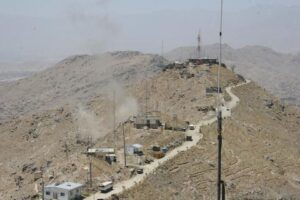Nestled at the foothills of Koh-e Asamai in Kabul, Afghanistan, the Asamai Hindu Temple stands as a beacon of the nation’s rich and diverse cultural tapestry. This ancient temple, dedicated to the Goddess Asha—revered as the embodiment of hope—has been a spiritual sanctuary for Afghan Hindus for centuries.
Historical Significance
The Koh-e Asamai mountain, often referred to as “Television Hill” due to the prominent TV mast at its summit, derives its name from this sacred temple. The term “Asamai” is believed to originate from “Asha Mai,” symbolizing the Goddess of Hope. Devotees hold that the goddess has resided atop this hill since time immemorial, offering solace and inspiration to those who seek her blessings.
One of the temple’s most remarkable features is the Akhand Jyoti, an eternal flame that has purportedly burned uninterrupted for over 4,000 years. This enduring flame serves as a powerful symbol of resilience and unwavering faith, having withstood numerous periods of conflict and change throughout Afghanistan’s tumultuous history.
Cultural and Religious Importance
For the Hindu community in Afghanistan, the Asamai Temple is more than just a place of worship; it is a cornerstone of cultural identity and continuity. The temple has witnessed countless celebrations, rituals, and gatherings, fostering a sense of unity and belonging among Afghan Hindus. Even during times of adversity, the temple has remained a sanctuary, embodying the enduring spirit of the community.
Preservation Efforts
In recognition of its profound significance, efforts have been made to preserve and restore the Asamai Temple. In 2006, philanthropist Ehsan Bayat funded a renovation project, ensuring that this sacred site continues to stand as a testament to Afghanistan’s multicultural heritage.
Global Influence
The legacy of the Asamai Temple extends far beyond Kabul. Afghan Hindu communities around the world have established temples named after Asamai, reflecting the deep-rooted connection and reverence they hold for this sacred site. These temples serve as cultural hubs, preserving traditions and fostering a sense of community among the Afghan Hindu diaspora.
Conclusion
The Koh-e Asamai Hindu Temple stands as a symbol of hope, resilience, and the rich cultural mosaic that defines Afghanistan. Its enduring presence amidst the challenges of history underscores the importance of preserving such sites, not only for their religious significance but also for their role in promoting cultural diversity and understanding.





For more updates and detailed coverage of this case and other issues affecting the Hindu and Sindhi communities in Sindh, Pakistan, stay tuned to Sindh Renaissance.






